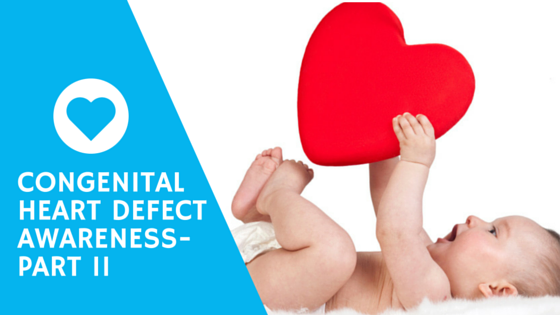
Welcome to part 2 of a series aimed at increasing congenital heart defect awareness. In part 1, we looked at the types, symptoms and causes of this illness. In part 2, we will take a look at the currently available treatments for this condition and the ongoing research efforts to treat CHD using stem cells.
How Congenital Heart Disease is Treated?
In many cases, congenital heart defects don’t need to be treated because their symptoms are not severe. If the defect is a very small hole in a section of the heart, it can even heal on its own.However, If treatment is required, there are three options which are frequently used:
Catheter Procedures
This is a less invasive procedure than other surgical treatments for CHD. To repair a CHD, the catheter is typically inserted into a vein or artery and guided to the site of the heart defect. It is often used to treat minor congenital heart defects, including atrial septal defect (ASD) and pulmonary valve stenosis (Nhlbi.nih.gov, 2016).
In some cases, devices are attached to the catheter, which can be used to seal congenital defects that have caused a hole in the heart. By reducing the size of the hole, the device can help the heart heal the hole over time.
If the congenital heart defect involves narrowed valves, a balloon can be attached to the catheter to stretch the size of the valve. The balloon reaches the site of the valve, is inflated to enlarge the hole, then deflated and removed. A variety of technologies are used to help doctors perform these procedures including echocardiography, transesophageal echo, and coronary angiography.
Surgery
If a catheter cannot be used to repair the anomaly, more extensive surgery may be required. In many cases, a surgeon may be able to repair the problem completely with one surgical procedure, but in some cases a number of procedures may be required.
Some of the ways in which surgical procedures can be used to repair congenital heart defects include:
- Repairing heart valves or replacing them
- Closing holes in the heart with inserts or stitches.
- Widening narrow arteries and heart valves
- Repairing more complex defects in the heart
Pharmaceuticals
Some pharmaceuticals can be used to treat CHD symptoms. Some of the tasks that can be performed with drugs include helping the heart regulate its heartbeat, making a heart stronger while it is repaired, and widening the blood vessels, so blood can move more easily.
Treating CHD Using Stem Cells
Most of the research efforts going into curing or treating CHD revolve around improving pharmaceuticals or surgical procedures. However in the past 10-years, researchers have begun to look more closely at the use of stem cells to treat congenital heart defects.
An editorial by Brody Lehman and Sunjay Kaushal, published in 2015, suggests that more than 5,000 patients have already received stem cells to treat some form of cardiovascular disease (Wehman & Kaushal, 2015). They suggest that Mesenchymal Stem Cells (MSCs) may show the greatest potential for repairing the heart after injury or to repair a congenital defect.
Mesenchymal stem/stromal cells (MSCs) can be found in the bone marrow stroma and are capable of differentiating into a range of cells including into osteoblasts, chondrocytes, and adipocytes. These stem cells can also differentiate into spontaneously beating cardiomyocytes (heart cells) after exposure to the demethylating agent 5-azacytidine in vitro (Bernstein & Srivastava, 2012).
Researchers have been able to create heart cells from MSCs and transplant them into animals with varying degrees of success. Once the cardiomyocytes arrive at the heart they begin to repair the heart tissue and potentially have a role in repairing congenital heart defects.
Embryonic stem (ES) cells and induced pluripotent stem (iPS) cells can also be used to create cardiomyocytes for tissue repair, although there are some ethical considerations with using embryonic cells.
Researchers have also shown that MSCs derived from amniotic fluid may have potential to treat congenital heart defects (ScienceDaily, 2016). Scientists converted the MSCs from amniotic fluid into induced pluripotent cells (iPSCs). These cells have the same genetic makeup as the foetus, so they won’t be rejected. Pluripotent stem cells can differentiate into almost any type of cell including heart cells. The were able to create heart cells in vitro and are looking at the best technique for transplanting these cells.
The Mayo Clinic are currently running a trial for the use of umbilical cord blood stem cells to treat congenital heart disease (Mayo.edu, 2016). They are particularly interested with testing the feasibility of umbilical cord stem cells for treating a CHD called hypoplastic left heart syndrome.
Researchers hope that stem cells can be used to develop effective new treatment regimes for congenital heart disease. The results of the research so far have been overwhelmingly positive and the next few years are sure to bring some exciting announcements.
Read Congenital Heart Defect Awareness Part 1 >>
Source
Bernstein, H., & Srivastava, D. (2012). Stem cell therapy for cardiac disease. Pediatr Res, 71(4-2), 491-499. http://dx.doi.org/10.1038/pr.2011.61WebMD,. (2016). Congenital Heart Defects-Treatment Overview. Retrieved 4 February 2016, from http://www.webmd.com/heart-disease/tc/congenital-heart-defects-treatment-overview
Nhlbi.nih.gov,. (2016). How Are Congenital Heart Defects Treated? – NHLBI, NIH. Retrieved 4 February 2016, from https://www.nhlbi.nih.gov/health/health-topics/topics/chd/treatment
Mayo.edu,. (2016). Umbilical Cord Blood Collection and Processing for Cardiac Regeneration in Hypoplastic Left Heart Syndrome Patients – Mayo Clinic. Retrieved 4 February 2016, from http://www.mayo.edu/research/clinical-trials/cls-20112061
ScienceDaily,. (2016). Amniotic stem cells show promise in repair of cardiac birth defects. Retrieved 4 February 2016, from http://www.sciencedaily.com/releases/2013/10/131009125951.htm
Wehman, B., & Kaushal, S. (2015). The Emergence of Stem Cell Therapy for Patients With Congenital Heart Disease. Circulation Research, 116(4), 566-569. http://dx.doi.org/10.1161/circresaha.115.305821
* * * * * *
Did you know that one of the very best things you can do to ensure the future health of your child is actually a decision you can make at birth? Click here to learn more >>
{{cta(‘f46d5df3-d06d-457c-b28d-d46e1e2a802c’)}}


